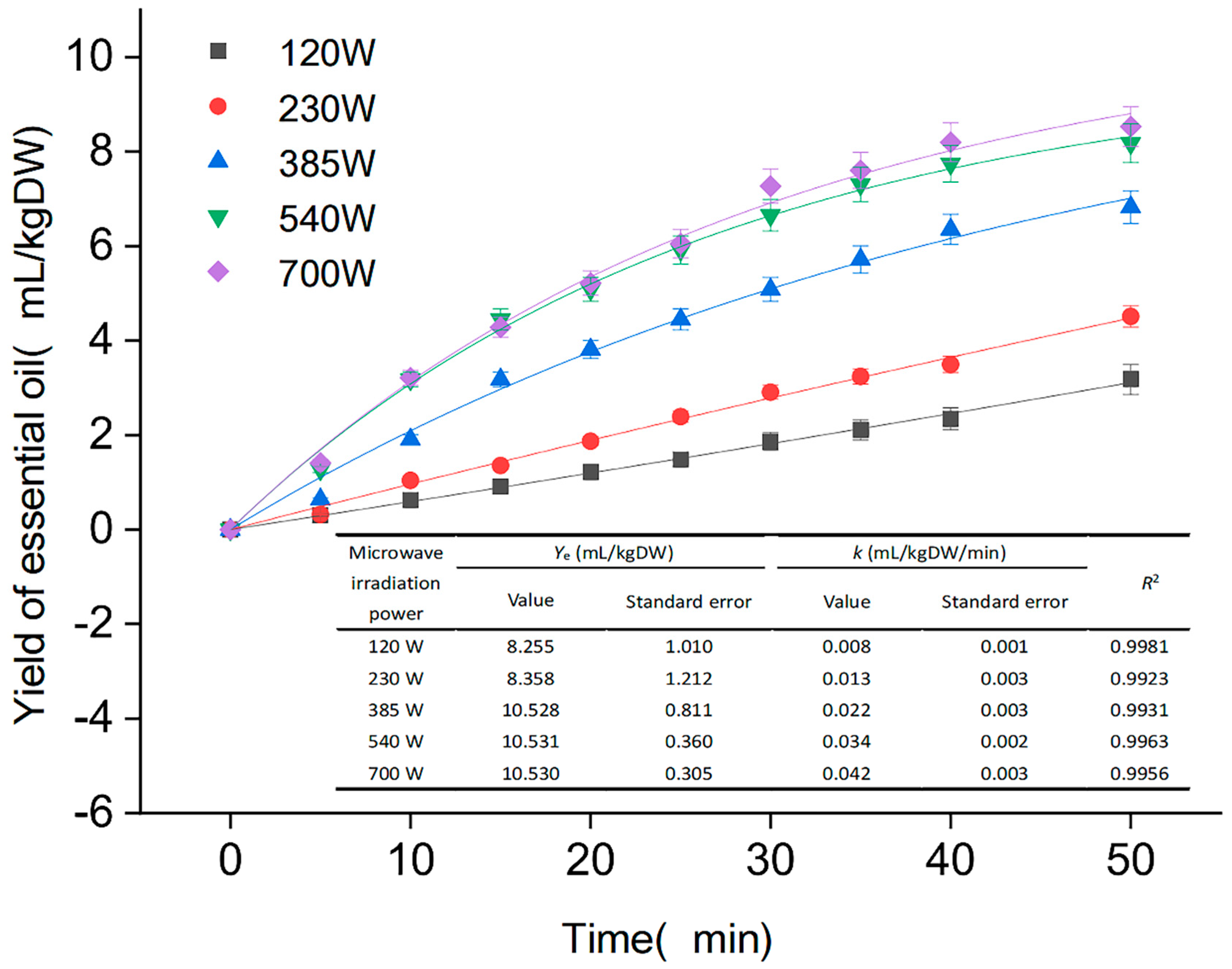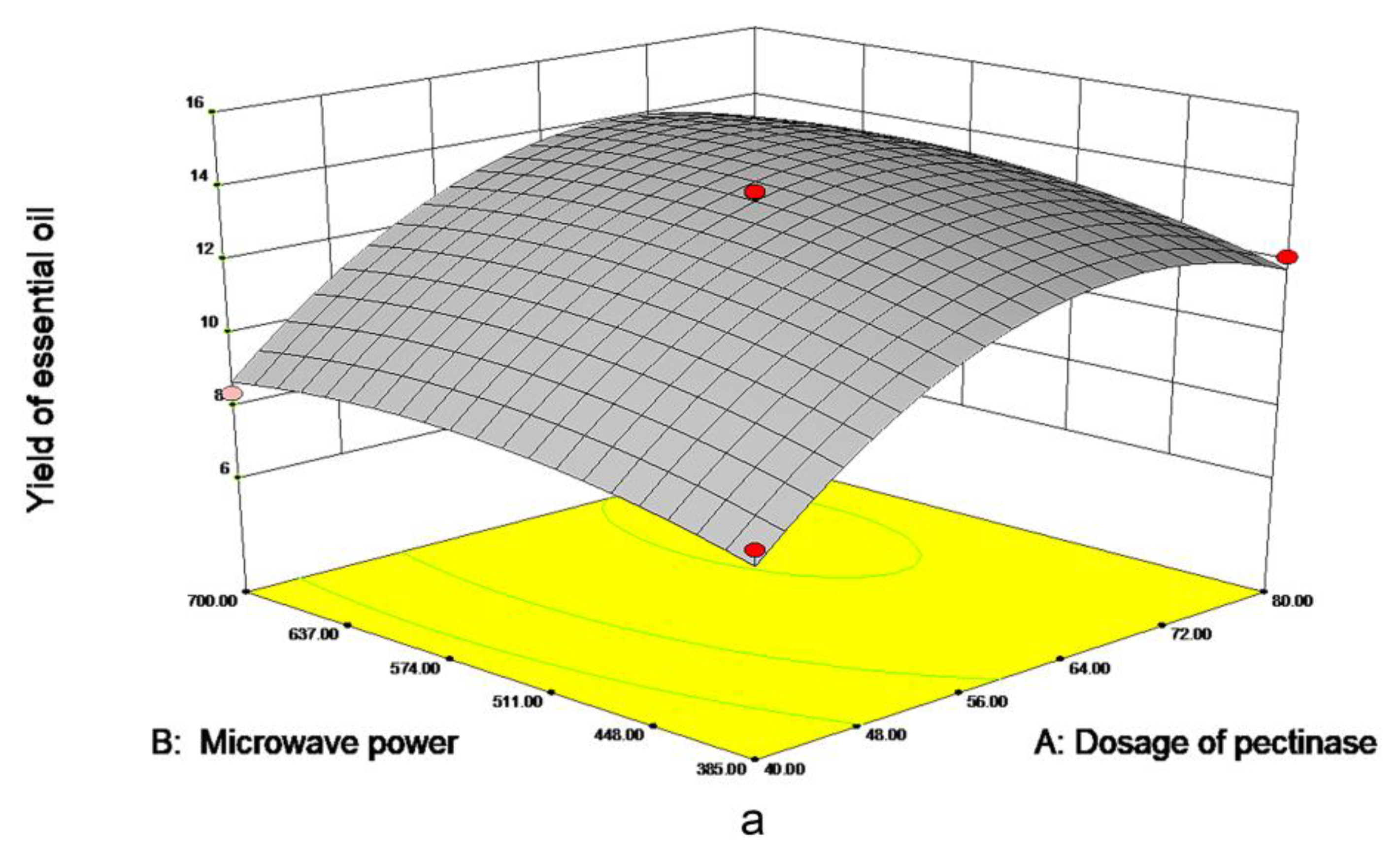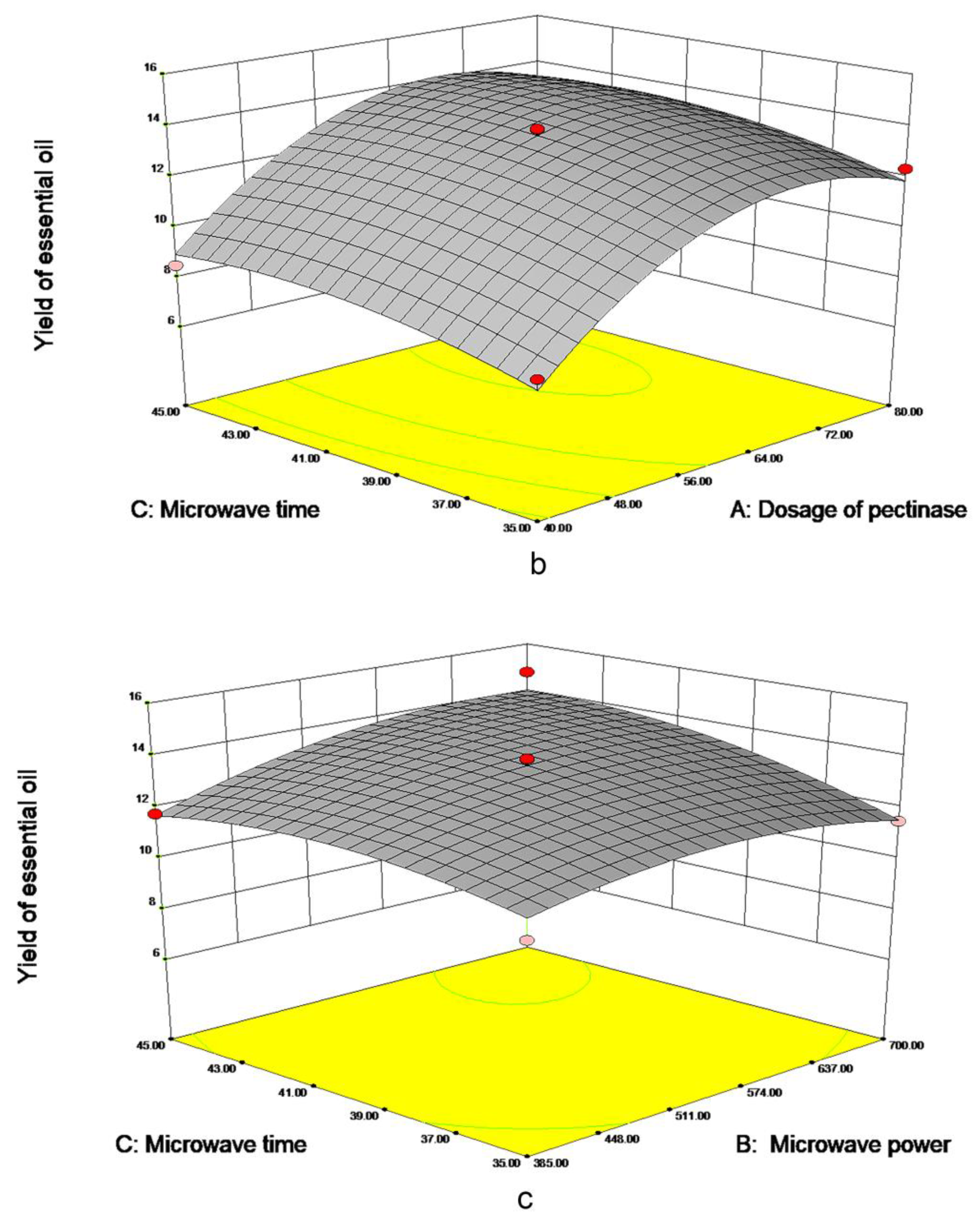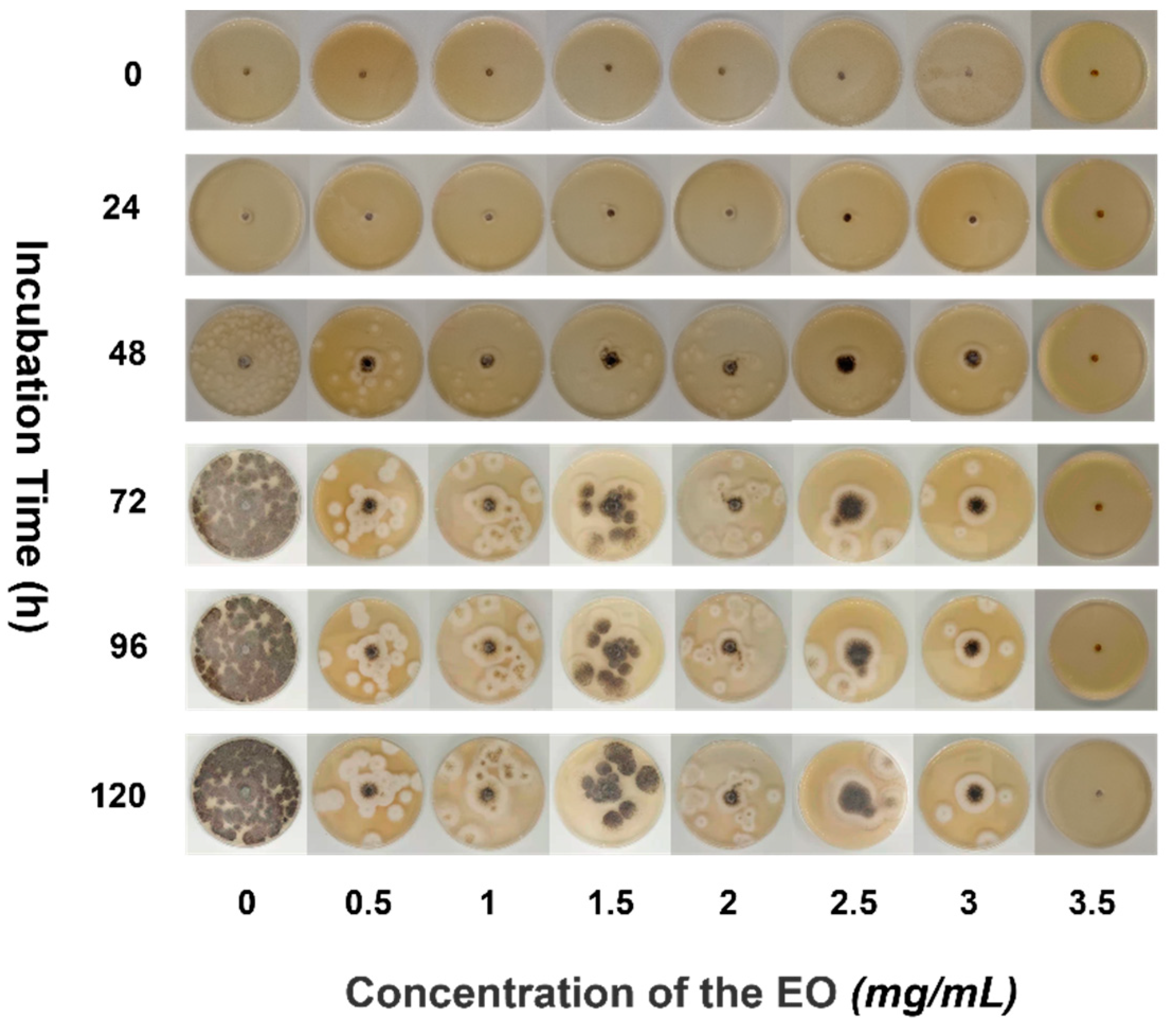The Preparation of the Essential Oil from Pomelo (Citrus maxima ‘Shatian Yu’) Peel Using Microwave-Assisted Distillation by Pectinase Soaking and Its Anti-Fungal Activity
Abstract
:1. Introduction
2. Materials and Methods
2.1. Materials and Apparatus
2.2. Pretreatment and EO Separation
2.3. Single-Factor and Response Surface Experiments Optimization
2.4. GC-MS Detection
2.5. Pseudocercospora Isolation
2.6. Antifungal Experiment
3. Results and Discussion
3.1. Extraction and Optimization of EOs
3.1.1. Extraction Rate under Different Factor Levels
3.1.2. Extraction Kinetics
3.1.3. Response Surface Optimization
3.1.4. Validation Test
3.2. EO Compounds
3.3. Bioactivity of Essential Oils
3.3.1. Pseudocercospora Isolation
3.3.2. Antifungal Process
4. Conclusions
Author Contributions
Funding
Data Availability Statement
Conflicts of Interest
References
- Dehghani Bidgoli, R. Chemical Composition of Essential Oil and Antifungal Activity of Artemisia Persica boiss. from Iran. J. Food Sci. Technol. 2021, 58, 1313–1318. [Google Scholar] [CrossRef]
- Darmadi, A.A.K.; Sudirga, S.K.; Suriani, N.L.; Wahyuni, I.G.A.S. Antifungal Activities of Cinnamon Leaf Extracts against Sigatoka Fungus (Pseudocercospora fijiensis). IOP Conf. Ser. Earth Environ. Sci. 2019, 347, 012051. [Google Scholar] [CrossRef]
- Seshadri, V.D.; Balasubramanian, B.; Al-Dhabi, N.A.; Esmail, G.A.; Arasu, M.V. Essential Oils of Cinnamomum Loureirii and Evolvulus Alsinoides Protect Guava Fruits from Spoilage Bacteria, Fungi and Insect (Pseudococcus longispinus). Ind. Crops Prod. 2020, 154, 112629. [Google Scholar] [CrossRef]
- Chen, C.J.; Li, Q.Q.; Ma, Y.N.; Wang, W.; Cheng, Y.X.; Xu, F.R.; Dong, X. Antifungal Effect of Essential Oils from Five Kinds of Rutaceae Plants—Avoiding Pesticide Residue and Resistance. Chem. Biodivers. 2019, 16, e1800688. [Google Scholar] [CrossRef]
- Brauer, V.S.; Rezende, C.P.; Pessoni, A.M.; De Paula, R.G.; Rangappa, K.S.; Nayaka, S.C.; Gupta, V.K.; Almeida, F. Antifungal Agents in Agriculture: Friends and Foes of Public Health. Biomolecules 2019, 9, 521. [Google Scholar] [CrossRef] [Green Version]
- Nguyen, V.T. Sunlight-Driven Synthesis of Silver Nanoparticles Using Pomelo Peel Extract and Antibacterial Testing. J. Chem. 2020, 2020, 6407081. [Google Scholar] [CrossRef]
- Xiao, L.; Ye, F.; Zhou, Y.; Zhao, G. Utilization of Pomelo Peels to Manufacture Value-Added Products: A Review. Food Chem. 2021, 351, 129247. [Google Scholar] [CrossRef]
- Dao, T.P.; Phong, H.X.; Cang, M.H.; Bach, L.G.; Van Muoi, N. Kinetic Modeling of Essential Oil Hydro-Distillation from Peels of Pomelo (Citrus grandis L.) Fruit Grown in Southern Vietnam. Sains Malays. 2021, 50, 3251–3261. [Google Scholar]
- Tuan, N.T.; Dang, L.N.; Huong, B.T.C.; Danh, L.T. One Step Extraction of Essential Oils and Pectin from Pomelo (Citrus grandis) Peels. Chem. Eng. Process. Process Intensif. 2019, 142, 107550. [Google Scholar] [CrossRef]
- Peng, X.; Feng, C.; Wang, X.; Gu, H.; Li, J.; Zhang, X.; Zhang, X.; Yang, L. Chemical Composition and Antioxidant Activity of Essential Oils from Barks of Pinus Pumila Using Microwave-Assisted Hydrodistillation after Screw Extrusion Treatment. Ind. Crops Prod. 2021, 166, 113489. [Google Scholar] [CrossRef]
- Peng, X.; Yang, X.; Gu, H.; Yang, L.; Gao, H. Essential Oil Extraction from Fresh Needles of Pinus Pumila (Pall.) Regel Using a Solvent-Free Microwave-Assisted Methodology and an Evaluation of Acetylcholinesterase Inhibition Activity in Vitro Compared to That of Its Main Components. Ind. Crops Prod. 2021, 167, 113549. [Google Scholar] [CrossRef]
- Megawati; Fardhyanti, D.S.; Sediawan, W.B.; Hisyam, A. Kinetics of Mace (Myristicae arillus) Essential Oil Extraction Using Microwave Assisted Hydrodistillation: Effect of Microwave Power. Ind. Crops Prod. 2019, 131, 315–322. [Google Scholar]
- Valderrama, F.; Ruiz, F. An Optimal Control Approach to Steam Distillation of Essential Oils from Aromatic Plants. Comput. Chem. Eng. 2018, 117, 25–31. [Google Scholar] [CrossRef]
- Kawai, H.; Kuraya, E.; Touyama, A.; Higa, O.; Hokamoto, K.; Tokeshi, K.; Yasuda, A.; Naragaki, T.; Itoh, S. Improved Yield and Antioxidant Activity of Essential Oil from Alpinia Zerumbet (Zingiberaceae) Leaves by Underwater Shockwave Pretreatment. Food Bioprod. Process. 2021, 125, 134–140. [Google Scholar] [CrossRef]
- Zhao, S.; Baik, O.D. Application of Ultrasound as Pretreatment for Extraction of Podophyllotoxin from Rhizomes of Podophyllum Peltatum. Ultrason. Sonochem. 2012, 19, 22–31. [Google Scholar] [CrossRef]
- Trujillo-Juárez, L.G.; Hernández-Meléndez, Ó.; Gimeno, M.; Gracia-Fadrique, J.; Bárzana, E. Extraction of Essential Oil from Waste Grapefruit Peel Using a Pilot-Scale Twin-Screw Extruder. ACS Food Sci. Technol. 2021, 1, 1198–1205. [Google Scholar] [CrossRef]
- Li, Q.; Zhou, Z.; Zhang, D.; Wang, Z.; Cong, W. Lipid Extraction from Nannochloropsis Oceanica Biomass after Extrusion Pretreatment with Twin-Screw Extruder: Optimization of Processing Parameters and Comparison of Lipid Quality. Bioprocess Biosyst. Eng. 2020, 43, 655–662. [Google Scholar] [CrossRef]
- Uitterhaegen, E.; Nguyen, Q.H.; Sampaio, K.A.; Stevens, C.V.; Merah, O.; Talou, T.; Rigal, L.; Evon, P. Extraction of Coriander Oil Using Twin-Screw Extrusion: Feasibility Study and Potential Press Cake Applications. JAOCS J. Am. Oil Chem. Soc. 2015, 92, 1219–1233. [Google Scholar] [CrossRef] [Green Version]
- Ming, Z.Q.; Liu, Y.Q.; Ye, Y.Y.; Li, S.R.; Zhao, Y.R.; Wang, D. Study of a New Combined Method for Pre-Extraction of Essential Oils and Catalytic Fast Pyrolysis of Pine Sawdust. Energy 2016, 116, 558–566. [Google Scholar] [CrossRef]
- Li, Z.; Wang, H.; Pan, X.; Guo, Y.; Gao, W.; Wang, J.; Dong, B.; Duan, M.; Yin, H.; Zhang, Q. Enzyme-Deep Eutectic Solvent Pre-Treatment for Extraction of Essential Oil from Mentha Haplocalyx Briq. Leaves: Kinetic, Chemical Composition and Inhibitory Enzyme Activity. Ind. Crops Prod. 2022, 177, 114429. [Google Scholar] [CrossRef]
- Marjamaa, K.; Kruus, K. Enzyme Biotechnology in Degradation and Modification of Plant Cell Wall Polymers. Physiol. Plant. 2018, 164, 106–118. [Google Scholar] [CrossRef] [PubMed]
- Feng, Y.N.; Zhang, X.F. Polysaccharide extracted from Huperzia serrata using response surface methodology and its biological activity. Int. J. Biol. Macromol. 2020, 157, 267–275. [Google Scholar] [CrossRef] [PubMed]
- Hu, B.; Li, Y.; Song, J.; Li, H.; Zhou, Q.; Li, C.; Zhang, Z.; Liu, Y.; Liu, A.; Zhang, Q. Oil extraction from tiger nut (Cyperus esculentus L.) using the combination of microwave-ultrasonic assisted aqueous enzymatic method—Design, optimization and quality evaluation. J. Chromatogr. A 2020, 1627, 461380. [Google Scholar] [CrossRef]
- Jiao, Z.; Zhang, Y.; Fan, H. Ultrasonic-microwave method in preparation of polypyrrole-coated magnetic particles for vitamin D extraction in milk. J. Chromatogr. A 2016, 1457, 7–13. [Google Scholar] [CrossRef] [PubMed]
- Sagarika, N.; Prince, M.V.; Kothakota, A.; Pandiselvam, R.; Sreeja, R.; Mathew, S.M. Characterization and Optimization of Microwave Assisted Process for Extraction of Nutmeg (Myristica fragrans Houtt.) Mace Essential Oil. J. Essent. Oil Bear. Plants 2018, 21, 895–904. [Google Scholar] [CrossRef]
- Zhang, H.; Cai, X.T.; Tian, Q.H.; Xiao, L.X.; Zeng, Z.; Cai, X.; Yan, J.; Li, Q.Y. Microwave-Assisted Degradation of Polysaccharide from Polygonatum sibiricum and Antioxidant Activity. J. Food Sci. 2019, 84, 754–761. [Google Scholar] [CrossRef]
- Jeyaratnam, N.; Nour, A.H.; Kanthasamy, R.; Nour, A.H.; Yuvaraj, A.R.; Akindoyo, J.O. Essential Oil from Cinnamomum Cassia Bark through Hydrodistillation and Advanced Microwave Assisted Hydrodistillation. Ind. Crops Prod. 2016, 92, 57–66. [Google Scholar] [CrossRef] [Green Version]
- Srinivas, Y.; Mathew, S.M.; Kothakota, A.; Sagarika, N.; Pandiselvam, R. Microwave Assisted Fluidized Bed Drying of Nutmeg Mace for Essential Oil Enriched Extracts: An Assessment of Drying Kinetics, Process Optimization and Quality. Innov. Food Sci. Emerg. Technol. 2020, 66, 102541. [Google Scholar] [CrossRef]
- Nagendra Chari, K.L.; Manasa, D.; Srinivas, P.; Sowbhagya, H.B. Enzyme-Assisted Extraction of Bioactive Compounds from Ginger (Zingiber officinale Roscoe). Food Chem. 2013, 139, 509–514. [Google Scholar] [CrossRef]
- Chen, Q.; Hu, Z.; Yao, F.Y.D.; Liang, H. Study of Two-Stage Microwave Extraction of Essential Oil and Pectin from Pomelo Peels. LWT 2016, 66, 538–545. [Google Scholar] [CrossRef]
- Liu, Z.; Li, H.; Zhu, Z.; Huang, D.; Qi, Y.; Ma, C.; Zou, Z.; Ni, H. Cinnamomum Camphora Fruit Peel as a Source of Essential Oil Extracted Using the Solvent-Free Microwave-Assisted Method Compared with Conventional Hydrodistillation. LWT 2022, 153, 112549. [Google Scholar] [CrossRef]
- Rguez, S.; Djébali, N.; Ben Slimene, I.; Abid, G.; Hammemi, M.; Chenenaoui, S.; Bachkouel, S.; Daami-Remadi, M.; Ksouri, R.; Hamrouni-Sellami, I. Cupressus Sempervirens Essential Oils and Their Major Compounds Successfully Control Postharvest Grey Mould Disease of Tomato. Ind. Crops Prod. 2018, 123, 135–141. [Google Scholar] [CrossRef]
- Xie, Y.; Wang, Z.; Huang, Q.; Zhang, D. Antifungal Activity of Several Essential Oils and Major Components against Wood-Rot Fungi. Ind. Crops Prod. 2017, 108, 278–285. [Google Scholar] [CrossRef]
- Uysal, B.; Sozmen, F.; Aktas, O.; Oksal, B.S.; Kose, E.O. Essential Oil Composition and Antibacterial Activity of the Grapefruit (Citrus paradisi. L.) Peel Essential Oils Obtained by Solvent-Free Microwave Extraction: Comparison with Hydrodistillation. Int. J. Food Sci. Technol. 2011, 46, 1455–1461. [Google Scholar] [CrossRef]
- Viuda-Martos, M.; Ruiz-Navajas, Y.; Fernández-López, J.; Pérez-Álvarez, J. Antifungal Activity of Lemon (Citrus lemon L.), Mandarin (Citrus reticulata L.), Grapefruit (Citrus paradisi L.) and Orange (Citrus sinensis L.) Essential Oils. Food Control 2008, 19, 1130–1138. [Google Scholar] [CrossRef]





| Factor | Unit | Level | ||
|---|---|---|---|---|
| −1 | 0 | 1 | ||
| Dosage of cellulase (X1) | μmol/g | 60 | 80 | 100 |
| Microwave irradiation power (X2) | W | 385 | 540 | 700 |
| Microwave irradiation time (X3) | min | 35 | 40 | 45 |
| Run | BBD Experiments | ANOVA | |||||||||||
|---|---|---|---|---|---|---|---|---|---|---|---|---|---|
| X1 | X2 | X3 | YEO | Source of Variation | Sum of Squares | Degree of Freedom | Mean Square | f-Value | p-Value | ||||
| 1 | 60 | 542.5 | 40 | 13.28 | Model | 91.17 | 9 | 10.13 | 88.06 | <0.0001 | |||
| 2 | 60 | 385 | 45 | 11.77 | X1 | 53.10 | 1 | 53.10 | 461.53 | <0.0001 | |||
| 3 | 80 | 542.5 | 45 | 13.98 | X2 | 5.64 | 1 | 5.64 | 49.07 | 0.0002 | |||
| 4 | 60 | 385 | 35 | 10.55 | X3 | 4.79 | 1 | 4.79 | 41.63 | 0.0003 | |||
| 5 | 40 | 700 | 40 | 8.38 | X12 | 17.31 | 1 | 17.31 | 150.49 | <0.0001 | |||
| 6 | 40 | 542.5 | 35 | 7.98 | X22 | 2.04 | 1 | 2.04 | 17.69 | 0.0040 | |||
| 7 | 60 | 542.5 | 40 | 13.61 | X32 | 3.59 | 1 | 3.59 | 31.16 | 0.0008 | |||
| 8 | 60 | 700 | 45 | 14.31 | X1X2 | 1.77 | 1 | 1.77 | 15.38 | 0.0057 | |||
| 9 | 60 | 542.5 | 40 | 13.59 | X1X3 | 0.32 | 1 | 0.32 | 2.77 | 0.1397 | |||
| 10 | 80 | 700 | 40 | 15.09 | X2X3 | 0.64 | 1 | 0.64 | 5.56 | 0.0504 | |||
| 11 | 60 | 700 | 35 | 11.49 | Residual | 0.81 | 7 | 0.12 | |||||
| 12 | 40 | 385 | 40 | 8.09 | Lack of fit | 0.56 | 3 | 0.19 | 2.99 | 0.1585 | |||
| 13 | 80 | 542.5 | 35 | 12.34 | Pure error | 0.25 | 4 | 0.062 | |||||
| 14 | 40 | 542.5 | 45 | 8.49 | Corrected total | 91.98 | 16 | 0.12 | |||||
| 15 | 80 | 385 | 40 | 12.14 | Credibility analysis of the regression equations | ||||||||
| 16 | 60 | 542.5 | 40 | 13.87 | Index mark | Standard deviation | Mean | CV% | Press | R2 | Adjust R2 | Predicted R2 | Adequacy precision |
| 17 | 60 | 542.5 | 40 | 13.89 | Y | 0.34 | 11.93 | 2.84 | 9.30 | 0.9912 | 0.9800 | 0.8989 | 28.355 |
| NO. a | RT (min) b | Compounds | Formula | RI c | CAS # | Content (%) | Similarity (%) | |
|---|---|---|---|---|---|---|---|---|
| EOA | EOB | |||||||
| 1 | 10.578 | α-pinene | C10H16 | 940 | 000080-56-8 | 1.87 | 1.11 | 96 |
| 2 | 12.287 | Myrcene | C10H16 | 992 | 000123-35-3 | 3.46 | 4.48 | 95 |
| 3 | 12.828 | α-Phellandrene | C10H16 | 1010 | 000099-83-2 | 4.72 | 5.70 | 80 |
| 4 | 15.384 | Limonene;(±)-1 | C10H16 | 1033 | 000138-86-3 | 79.31 | 76.12 | 99 |
| 5 | 16.506 | Linalool oxide | C10H18O2 | 1076 | 001365-19-1 | 0.16 | 0.15 | 91 |
| 6 | 17.099 | α-terpinolene | C10H16 | 1088 | 000586-62-9 | - | 0.11 | 95 |
| 7 | 17.464 | Linalool | C10H18O | 1106 | 000078-70-6 | 0.93 | 0.77 | 97 |
| 8 | 18.433 | 2-Cyclohexen-1-ol, 1-methyl-4-(1-methylethenyl)- | C10H16O | 1118 | 007212-40-0 | 0.13 | - | 96 |
| 9 | 21.560 | α-Terpineol | C10H18O | 1129 | 000098-55-5 | 0.49 | 0.40 | 90 |
| 10 | 21.959 | (-)-Trans-Isopiperitenol | C10H16O | 1210 | 074410-00-7 | 0.17 | - | 94 |
| 11 | 23.016 | Nerol;cis-Geraniol | C10H18O | 1229 | 000106-25-2 | 0.22 | 0.20 | 96 |
| 12 | 23.234 | Carveol | C10H16O | 1235 | 000099-48-9 | 0.19 | 0.21 | 98 |
| 13 | 23.569 | Z-Citral | C10H16O | 1249 | 000106-26-3 | 0.24 | 0.10 | 98 |
| 14 | 24.056 | Geraniol/Trans-Geraniol | C10H18O | 1267 | 000106-24-1 | 0.26 | 0.23 | 94 |
| 15 | 24.767 | Geranial/trans-Citral | C10H16O | 1272 | 000141-27-5 | 0.29 | 0.27 | 96 |
| 16 | 25.654 | Safrole | C10H10O2 | 1288 | 000094-59-7 | 0.14 | 0.11 | 97 |
| 17 | 27.787 | α-terpipene | C10H16 | 1320 | 000099-86-5 | 0.24 | 0.23 | 93 |
| 18 | 29.870 | Geranyl acetate | C12H20O2 | 1386 | 000105-87-3 | 0.37 | 0.56 | 91 |
| 19 | 31.277 | Methyleugenol | C11H14O2 | 1407 | 000093-15-2 | 2.12 | 1.01 | 98 |
| 21 | 32.288 | trans-Caryophyllene | C15H24 | 1442 | 000087-44-5 | 0.61 | 0.32 | 99 |
| 21 | 32.764 | 1-ethenyl-1-methyl-2-(1-methylethenyl)-4-(1-methylethylidene)- | C15H24 | 1486 | 003242-08-8 | - | 0.10 | 98 |
| 22 | 35.143 | β-Copaene | C15H24 | 1493 | 018252-44-3 | 0.18 | - | 97 |
| 23 | 48.739 | Nootkatone | C15H22O | 1797 | 004674-50-4 | 0.65 | 0.65 | 99 |
Publisher’s Note: MDPI stays neutral with regard to jurisdictional claims in published maps and institutional affiliations. |
© 2022 by the authors. Licensee MDPI, Basel, Switzerland. This article is an open access article distributed under the terms and conditions of the Creative Commons Attribution (CC BY) license (https://creativecommons.org/licenses/by/4.0/).
Share and Cite
Zhang, X.; Huang, Y.; Niu, Y.; Liu, Z.; Chen, M.; An, Y.; Zhang, L. The Preparation of the Essential Oil from Pomelo (Citrus maxima ‘Shatian Yu’) Peel Using Microwave-Assisted Distillation by Pectinase Soaking and Its Anti-Fungal Activity. Separations 2022, 9, 161. https://doi.org/10.3390/separations9070161
Zhang X, Huang Y, Niu Y, Liu Z, Chen M, An Y, Zhang L. The Preparation of the Essential Oil from Pomelo (Citrus maxima ‘Shatian Yu’) Peel Using Microwave-Assisted Distillation by Pectinase Soaking and Its Anti-Fungal Activity. Separations. 2022; 9(7):161. https://doi.org/10.3390/separations9070161
Chicago/Turabian StyleZhang, Xiaonan, Yan Huang, Yaqian Niu, Zhiwei Liu, Mengyu Chen, Yimin An, and Lubin Zhang. 2022. "The Preparation of the Essential Oil from Pomelo (Citrus maxima ‘Shatian Yu’) Peel Using Microwave-Assisted Distillation by Pectinase Soaking and Its Anti-Fungal Activity" Separations 9, no. 7: 161. https://doi.org/10.3390/separations9070161
APA StyleZhang, X., Huang, Y., Niu, Y., Liu, Z., Chen, M., An, Y., & Zhang, L. (2022). The Preparation of the Essential Oil from Pomelo (Citrus maxima ‘Shatian Yu’) Peel Using Microwave-Assisted Distillation by Pectinase Soaking and Its Anti-Fungal Activity. Separations, 9(7), 161. https://doi.org/10.3390/separations9070161






